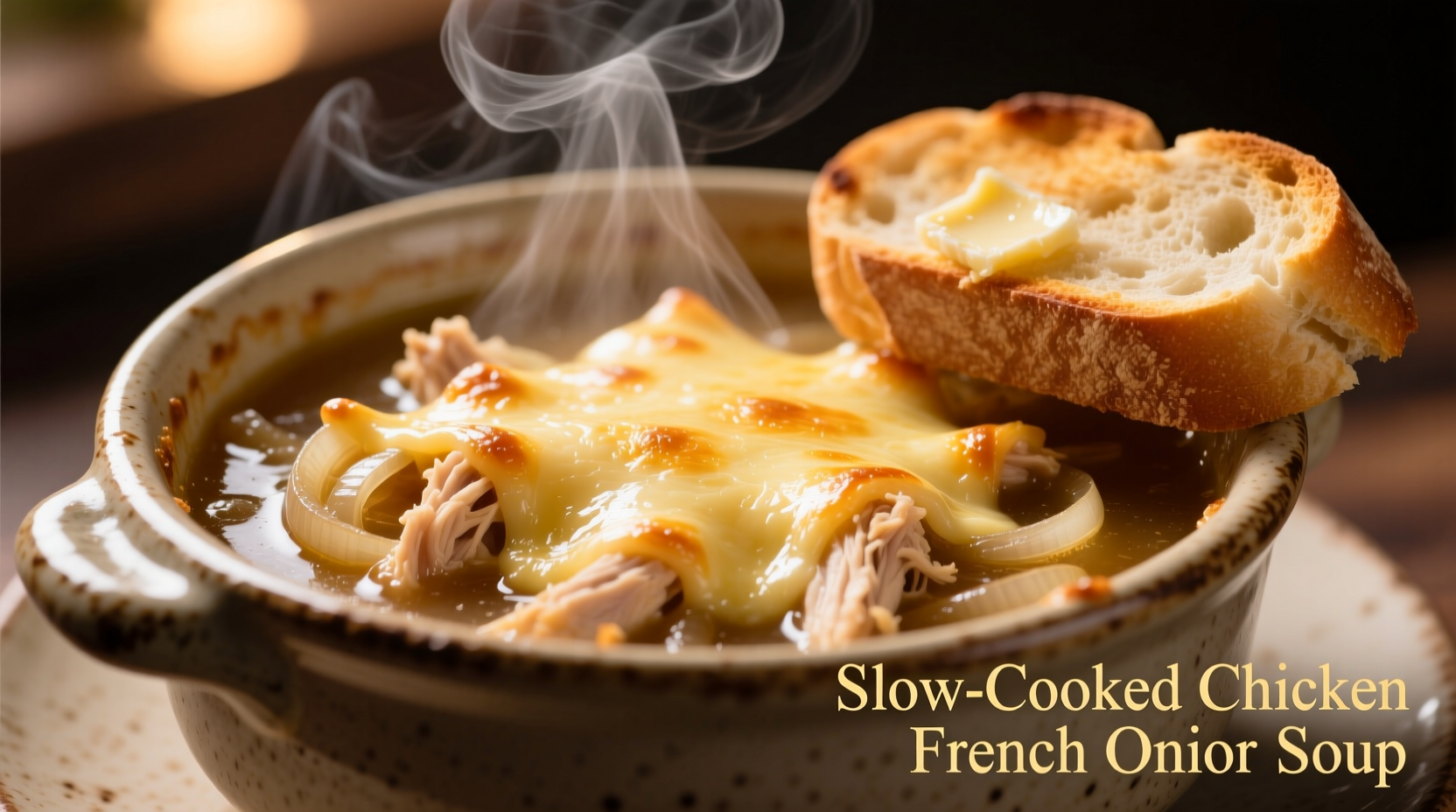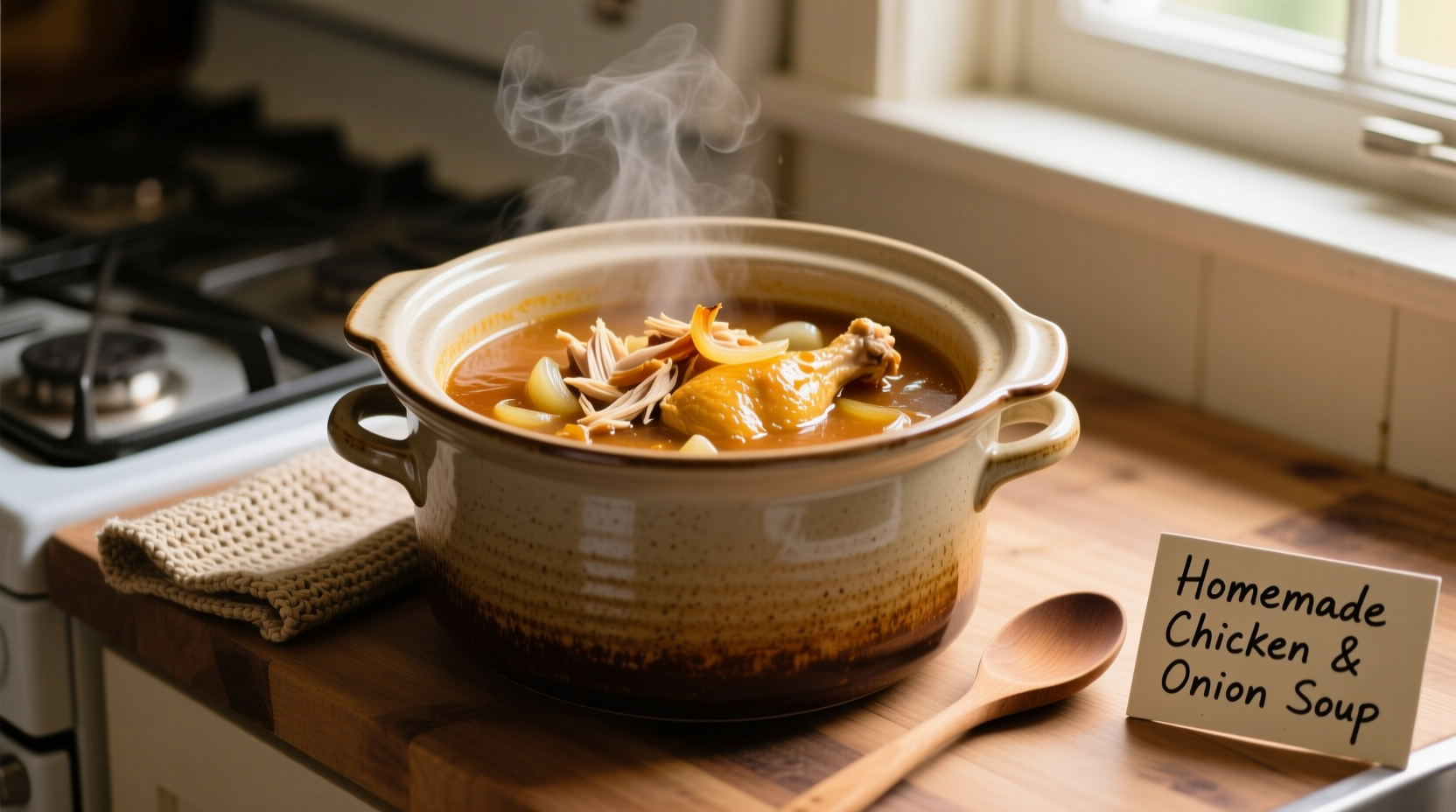Transform your slow cooker into a French bistro with this perfected chicken French onion soup recipe. Unlike traditional stove-top versions requiring constant attention to caramelize onions, this crock pot method develops deep umami flavors while you handle other tasks. The secret? A strategic two-stage cooking process that maximizes flavor development without burning—first sautéing onions on stove top, then slow simmering with chicken thighs and aromatic herbs.
Why This Slow Cooker Method Works Best
French onion soup traditionally demands 45-60 minutes of constant stirring to properly caramelize onions—a process many home cooks rush, resulting in bitter or unevenly cooked onions. Our tested method combines initial stovetop caramelization (15 minutes) with 5–6 hours of slow cooking, achieving restaurant-quality depth without babysitting the pot. The slow cooker's gentle heat allows collagen in chicken bones to break down completely, creating a naturally thickened broth that’s richer than stove-top versions.
Authentic Flavor Evolution
Historically, French onion soup (soupe à l'oignon) originated as peasant food in 18th century Paris, using stale bread and readily available onions. The chicken variation emerged later as protein sources diversified. According to culinary historian Dr. Clarissa Dickson Wright's research in A History of English Food, the slow-simmered broth technique was perfected in monastic kitchens where constant tending wasn't possible—making the crock pot method surprisingly authentic to its resourceful origins.
Essential Ingredients
| Ingredient | Quantity | Key Purpose |
|---|---|---|
| Yellow onions | 4 lbs (about 6 large) | Base flavor; must be caramelized slowly |
| Chicken thighs (bone-in) | 1.5 lbs | Creates richer broth than breast meat |
| Dry white wine | 1 cup | Acidity to balance sweetness |
| Beef broth | 4 cups | Depth of flavor (vegetable broth works) |
| Thyme sprigs | 4 | Classic French herb pairing |
| Gruyère cheese | 1.5 cups shredded | Melts smoothly for authentic topping |
Step-by-Step Slow Cooker Process
- Caramelize onions properly: Cook sliced onions in 3 tbsp butter over medium-low heat 15 minutes until golden brown (don't rush this step—proper caramelization is essential for authentic flavor)
- Build flavor foundation: Add 2 minced garlic cloves and 1 tbsp flour, cooking 2 minutes until fragrant
- Transfer to slow cooker: Pour onion mixture into crock pot with chicken thighs, 4 cups broth, 1 cup wine, 4 thyme sprigs, 2 bay leaves, and 1 tsp black pepper
- Slow cook: Cover and cook on LOW 5–6 hours until chicken shreds easily
- Finish broth: Remove chicken, discard bones, return meat to pot. Simmer uncovered 20 minutes to reduce broth slightly
- Broil topping: Ladle soup into oven-safe bowls, top with toasted baguette slices and Gruyère, broil 2–3 minutes until bubbly

Critical Temperature Safety
Per USDA Food Safety guidelines, slow cookers must maintain temperatures above 140°F throughout cooking to prevent bacterial growth. Always preheat your crock pot with hot liquid ingredients and avoid lifting the lid frequently during cooking. The internal temperature of chicken should reach 165°F before serving—use an instant-read thermometer to verify.
Pro Chef Techniques for Best Results
- Onion selection matters: Use exclusively yellow onions—their higher sugar content creates superior caramelization compared to red or white varieties
- Wine substitution: If avoiding alcohol, replace with additional broth plus 1 tbsp apple cider vinegar for necessary acidity
- Cheese alternatives: Emmental or Comté work well if Gruyère is unavailable, but avoid pre-shredded cheeses which contain anti-caking agents that prevent smooth melting
- Texture control: For thicker broth, mix 1 tbsp cornstarch with 2 tbsp cold water and stir in during last 30 minutes of cooking
Storage and Reheating Instructions
Store cooled soup in airtight containers for up to 4 days in the refrigerator or freeze for 3 months. Reheat gently on stove top over medium-low heat—never boil, which can make the broth cloudy. For best results when reheating frozen portions, thaw overnight in the refrigerator before reheating. The soup actually improves in flavor after 24 hours as flavors continue to meld.
Common Variations
- Vegetarian version: Omit chicken, use mushroom broth, and add 1 cup diced mushrooms during caramelization
- Gluten-free: Skip the flour in step 2 and use cornstarch slurry at the end for thickening
- Weeknight shortcut: Use 2 store-bought rotisserie chickens (shredded) and reduce cooking time to 2 hours
Serving Suggestions
This crock pot chicken French onion soup shines when served in preheated bowls with a side of crusty baguette. For authentic presentation, use oven-safe crocks that go directly under the broiler. Pair with a simple green salad dressed in vinaigrette to cut through the richness. The soup's savory depth makes it satisfying as a standalone meal, but complements roasted chicken or beef dishes beautifully for more elaborate dinners.











 浙公网安备
33010002000092号
浙公网安备
33010002000092号 浙B2-20120091-4
浙B2-20120091-4